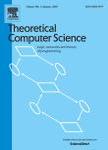版权所有:内蒙古大学图书馆 技术提供:维普资讯• 智图
内蒙古自治区呼和浩特市赛罕区大学西街235号 邮编: 010021

作者机构:Univ Canterbury Dept Comp Sci Christchurch 1 New Zealand
出 版 物:《THEORETICAL COMPUTER SCIENCE》 (理论计算机科学)
年 卷 期:2003年第293卷第3期
页 面:535-556页
核心收录:
学科分类:08[工学] 0812[工学-计算机科学与技术(可授工学、理学学位)]
主 题:algorithms Shortest path algorithms complexity classes vertex head Shortest path problem
摘 要:Dijkstra s algorithm solves the single-source shortest path problem on any directed graph in O(m + n log n) time when a Fibonacci heap is used as the frontier set data structure. Here n is the number of vertices and m is the number of edges in the graph. If the graph is nearly acyclic, other algorithms can achieve a time complexity lower than that of Dijkstra s algorithm. Abuaiadh and Kingston gave a single-source shortest path algorithm for nearly acyclic graphs with O(m + n log t) time complexity, where the new parameter, t, is the number of delete-min operations performed in priority queue manipulation. If the graph is nearly acyclic, then t is expected to be small, and the algorithm out-performs Dijkstra s algorithm. Takaoka, using a different definition for acyclicity, gave an algorithm with O(m + n log k) time complexity. In this algorithm, the new parameter, k, is the maximum cardinality of the strongly connected components in the graph. The generalised single-source (GSS) problem allows an initial distance to be defined at each vertex in the graph. Decomposing a graph into r trees allows the GSS problem to be solved within O(m + r log r) time. This paper presents a new all-pairs algorithm with a time complexity of O(mn + nr log r), where r is the number of acyclic parts resulting when the graph is decomposed into acyclic parts. The acyclic decomposition used is setwise unique and can be computed in O(mn) time. If the decomposition has been pre-calculated, then GSS can be solved within O(m + r log r) time whenever edge-costs in the graph change. A second new all-pairs algorithm is presented, with O(mn + nr 2) worst-case time complexity, where r is the number of vertices in a pre-calculated feedback vertex set for the nearly acyclic graph. For certain graphs, these new algorithms offer an improvement on the time complexity of the previous algorithms. (C) 2002 Elsevier Science B.V. All rights reserved.